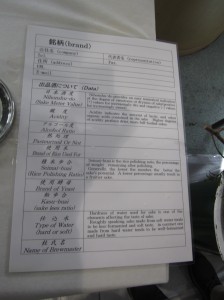De- received some free tickets for a sake festival that took place in Tokushima last weekend (February 26th). Since I have really come to appreciate the subtle differences in taste between sakes (and like to be a lush every once in awhile), me and her headed up to Tokushima at 7:00AM that lovely Saturday morning in order to get there by 9:00 and get an early start on sake taste-testing by 10:00, which is when the doors opened on the main facility. Once the doors opened, we got our cute little sake tasting cups and headed off to try doing a "sake taste-testing contest" before our tongues weren't sharp enough to taste the subtleties.
 The
contest was set up so that you could try taste-testing four different
types of labeled sake from the same company (a local company) first, and
then try and guess which type of sake was which from five unlabeled
bottles (one was meant to trick you). It was really difficult, and we
both only got one right (if you got three right, you got a prize, and
all four right was a better prize).
The
contest was set up so that you could try taste-testing four different
types of labeled sake from the same company (a local company) first, and
then try and guess which type of sake was which from five unlabeled
bottles (one was meant to trick you). It was really difficult, and we
both only got one right (if you got three right, you got a prize, and
all four right was a better prize).The other awesome thing that the festival allowed was the public viewing/touring of three local breweries (which, according to my friend, is pretty rare and she was REALLY excited about). The process of making sake can take weeks or months, depending on what type of sake is being made, the alcohol content, the degree to which the rice is polished.... it's all really quite confusing and labor intensive, but the end result is yummy so it's worth a short look at.
First, rice is picked and polished down to the appropriate size for the grade of sake that is being made (the more polishing, the finer the sake and the smaller the rice grains are once they are done being polished). Then, the rice is washed (in a very labor intensive process), steamed, and brought to hot rooms where they make koji. Koji, which is a mold that is dusted over the steamed rice, develops over a span of a few days, sitting in the hot room and growing on the steamed rice.
Since
the festival took place in Tokushima, and was only for Shikoku
breweries, we of course had to stop at my De-'s brewery's area and
try it in comparison (it stood up very well to the rest, of course!).
All in all, the day was very fun, very informative (not terribly drunk),
and a little tiring.








No comments:
Post a Comment